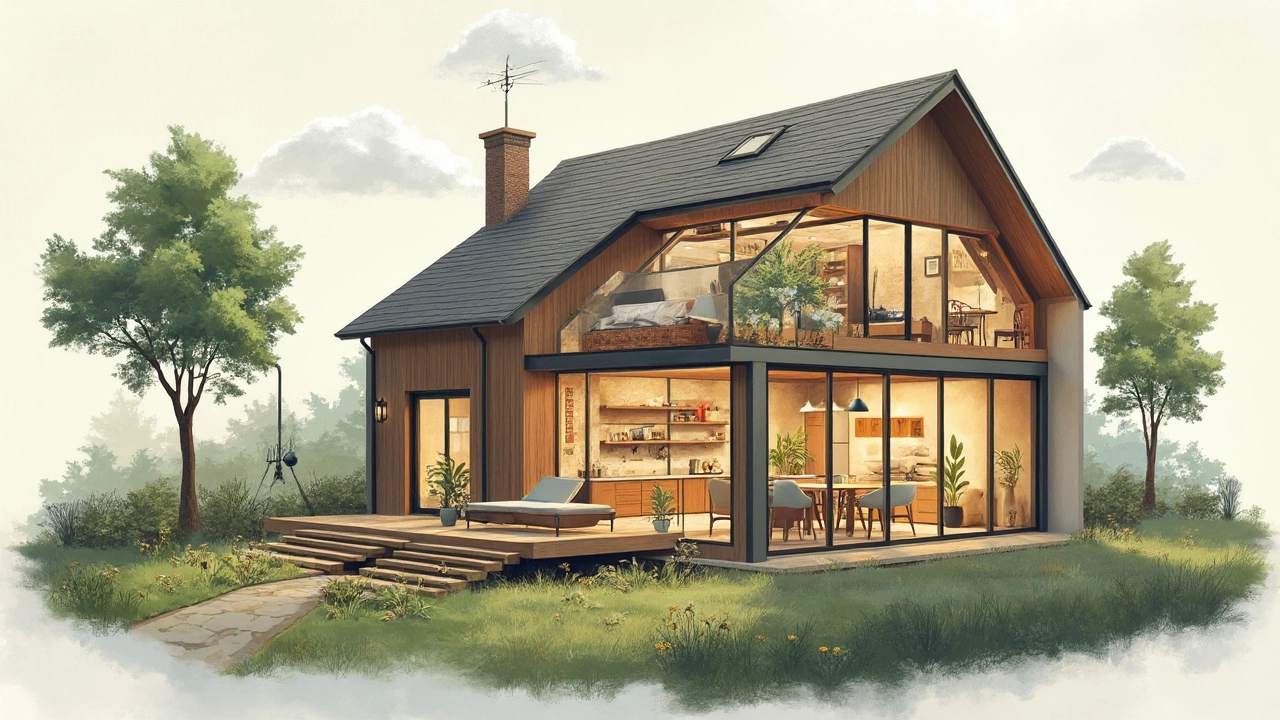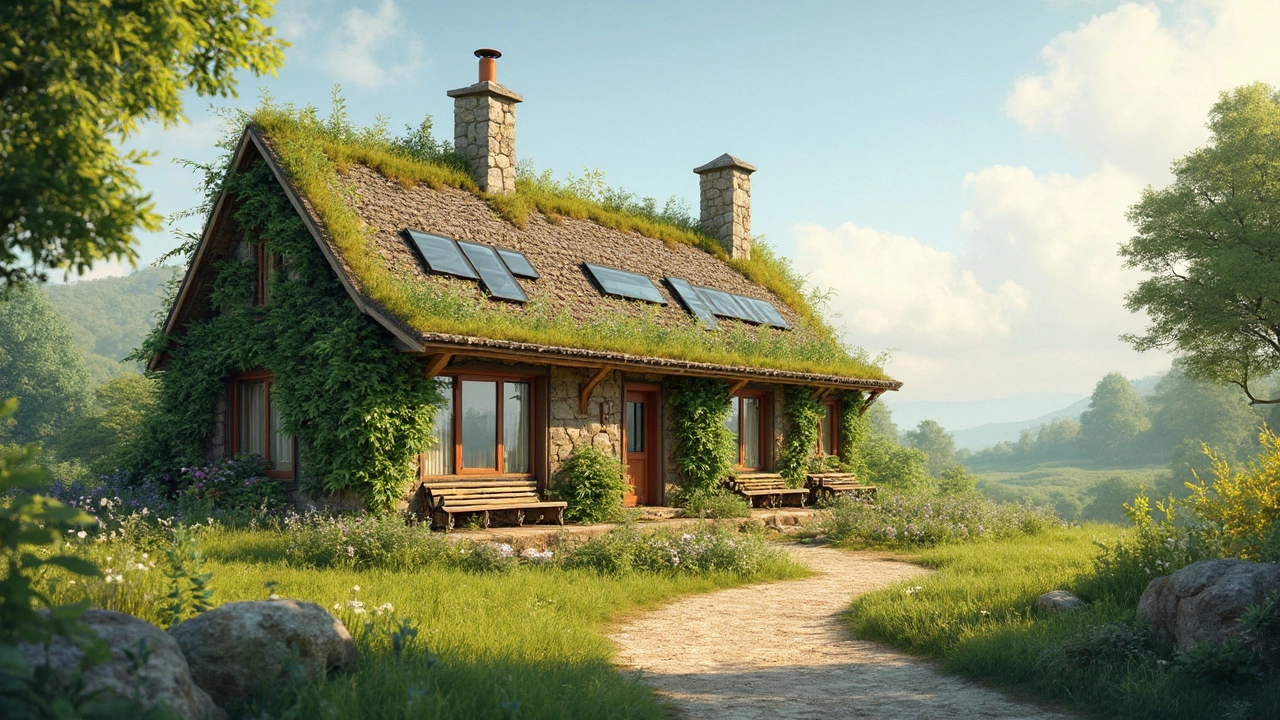Living in an eco-friendly home isn't just a trendy choice these days; it's a smart way to reduce your carbon footprint while still enjoying the comforts of modern life. But what exactly makes a home eco-friendly? Is it all about the solar panels, or is there more to it?
Let’s start with materials. Choosing sustainable building materials can make a big difference. Think bamboo flooring, recycled steel, or even straw bales. These materials don't just minimize environmental damage—they're surprisingly durable too.
Now, you might be wondering about energy efficiency. Well, it's more than just sticking solar panels on the roof. It's about designing your home to maximize natural light and insulation to help keep your energy bills low and reduce dependency on fossil fuels.
- Sustainable Materials
- Energy Efficiency
- Innovative Technologies
- Water Conservation
- Impact on Lifestyle
- Supporting Local Ecosystems
Sustainable Materials
Building a truly eco-friendly home starts with picking the right materials. You’d be surprised by how much what your home is made of can affect the environment. So, what's on the list of sustainable materials?
First up, bamboo. It's like the superhero of green building materials. Growing super fast and incredibly durable, bamboo is perfect for flooring and even walls. Plus, it doesn’t require replanting after harvest, making it highly renewable.
Another great choice is recycled steel. It might not sound as glamorous, but using recycled steel in your home can cut down the energy used in production by 75%. That’s huge when you're aiming for a more sustainable cottage.
Straw bales might seem a little out there, but they're excellent for insulation. Not to mention, they are super affordable and completely biodegradable. If you're looking at a rustic vibe, a straw bale house could be just the ticket.
But it's not just about what goes into the walls; finishes matter too. For paints and stains, look for ones that are low in volatile organic compounds (VOCs). These not only improve air quality but are also better for the environment.
- Bamboo – Quick-growing and great for floors and walls.
- Recycled Steel – Reduces energy usage significantly.
- Straw Bales – Biodegradable and great for insulation.
- Low-VOC Paints – Better air quality and eco-friendly.
When it comes to green living, even your choice of roofing materials matters. Cool roofs, made from highly reflective materials, not only keep your house cooler in summer but also reduce energy consumption and your air conditioning bills.
Take a moment to consider these options when planning your eco-friendly oasis or renovating. Choosing responsibly doesn’t just make your home better for the planet, but it can also enhance your quality of life at the same time.
Energy Efficiency
When we talk about making a home more eco-friendly, energy efficiency is right up there at the top of the list. It's not just about saving on those pesky utility bills; it's about big wins for the planet. So, how exactly can we make our cottages more energy efficient?
First things first—insulation. Think of insulation as your home's blanket. A well-insulated home keeps the heat in during the winter and out during the summer, meaning less need for energy-hungry heaters or air conditioners. Consider using materials like cellulose or sheep's wool for a greener choice.
Next up is the magic of passive solar design. This isn't about technology; it's about using the natural warmth of the sun to heat your home in winter. Sounds simple, right? By placing windows on the south side of your house and using proper shading, you can make the most of those sunny days without extra energy consumption.
Now, let's dive into lighting. LED bulbs use up to 75% less energy and last 25 times longer than incandescent lighting. Switching to LEDs is a no-brainer for sustainable cottages looking to cut down energy use.
Appliances also play a massive role. When it's time for an upgrade, go for those with the ENERGY STAR label. They might cost a bit more upfront, but they save you money in the long run with reduced energy consumption.
| Feature | Potential Energy Savings |
|---|---|
| LED Lighting | 75% |
| ENERGY STAR Appliances | 10-50% |
| Proper Insulation | 10-20% |
And then there's smart tech. Programmable thermostats, smart plugs, and energy monitors are game-changers. They help you pinpoint where you might be wasting energy and allow you to turn off devices remotely, ensuring nothing is using power when it doesn't need to.
Need another bonus? Making energy-efficient upgrades often qualifies for government rebates or tax incentives, so you get a little financial help along the way! Embracing these energy efficiency tips isn't just about going green; it's also about smart living.
Innovative Technologies
These days, making a home sustainable is often about getting tech-savvy. By integrating innovative technologies, you can transform your living space into an eco-friendly haven that keeps the planet and your wallet happy. But what kind of tech are we talking about?
First up, consider a smart home system. These systems help you manage energy use by automating lights, heating, and cooling. Imagine walking into a warm home without your heater running all day, thanks to smart thermostats that learn your habits and adjust accordingly.
Another big player in the eco-friendly homes game is energy storage technology. Products like the Tesla Powerwall store solar energy effectively, meaning you can still power your home when the sun's not shining. It's a great way to step up your green game and reduce your reliance on the grid.
And let’s not forget about water. Smart irrigation systems and low-flow fixtures can significantly cut down on water use without sacrificing comfort. Smart faucets and showers minimize wastage by monitoring usage and making real-time adjustments.
For the tech geeks out there, diving into eco-friendly cottages means looking at cutting-edge sustainable tech. Look out for building integrated photovoltaic panels (BIPV)—they replace conventional building materials, offering homes a clean and sleek energy solution without the bulkiness of traditional solar panels.
| Technology | Advantages |
|---|---|
| Smart Home Systems | Saves energy by automating home settings |
| Energy Storage | Utilizes stored solar power during off-peak times |
| Water Management | Reduces water consumption with smart controls |
So if you're planning an upgrade or building a new home, considering these innovative options can be both a smart and eco-friendly choice. They’re not just about the future—they’re here right now, making sustainable living a reality.

Water Conservation
Water might seem endless when it’s flowing out of the tap, but we all know it’s a precious resource, and conserving it is a big part of owning an eco-friendly home. One of the first things you can do is install low-flow fixtures. These are easy to find and drastically reduce water usage without sacrificing performance.
Another smart move is setting up a rainwater harvesting system. Imagine collecting all that rain instead of letting it go down the drain! Not only can you use it for gardening, but with proper filtration, it's possible to use rainwater for your home’s greywater systems.
Speaking of greywater, this system lets you reuse waste water from your sinks, showers, and washing machines for irrigation or flushing toilets. Efficiently using greywater conserves tons of resources over time.
Even your landscape choices play a part! Consider xeriscaping—using drought-resistant plants that need minimal watering. This not only saves water but also slashes gardening costs.
Incorporating these practices doesn’t just make your eco cottages greener—it saves you money and extends the life of public water infrastructure. It's all about creating a home that thinks ahead and does good for the planet.
Impact on Lifestyle
Switching to an eco-friendly home doesn't just benefit the planet; it can transform how you live day-to-day. Imagine waking up in a space that feels more connected to nature because it's designed with the environment in mind. From improved air quality to a serene atmosphere, your home might start feeling more like a sanctuary.
An eco-friendly lifestyle often means you embrace minimalism—not in giving up what you love but in making more conscious choices. This could mean opting for quality over quantity or repurposing items instead of disposing of them. Less clutter sometimes means less stress.
Your wallet could thank you too. Energy-efficient systems might lead to lower utility bills, saving you money over time. Smart designs that harness natural light and temperature regulation cut down on energy consumption, so you just might find yourself spending less on electricity.
Cooking in an eco-cottage kitchen might change how you view your meals. With rainwater collection systems and gardens designed for native plants, you might start growing some of your own ingredients. Suddenly, the idea of farm-to-table doesn't feel so distant.
Embracing this lifestyle can also spark a stronger community connection. Often, people living in eco-friendly communities engage more, sharing resources like tools or organizing cooperative gardens. It feels less like living in isolation and more like contributing to something greater.
Changing your home impacts the everyday details too—like remembering to recycle or finding local collection spots for electronic waste. It's all about building habits that align with your values and, in turn, support a greener world.
Supporting Local Ecosystems
So, why should a home or cottage be concerned with the local ecosystem? Well, a big part of living in an eco-friendly home is not just about what happens inside your house, but also what goes on around it. These homes can act as a friend to local plants and animals, helping maintain the balance of nature in your neighborhood. Sounds pretty cool, right?
One easy way to support local ecosystems is by landscaping with native plants. These are plants that naturally occur in your area and are adapted to the local climate and soil conditions. By using native plants, you not only conserve water but also provide food and habitat for local wildlife. This makes your garden a mini ecosystem supporting birds, bees, and even butterflies!
But wait, there’s more. Keeping harmful chemicals out of your garden is crucial. Choosing organic fertilizers and pesticides, or better yet, using compost you create, keeps the toxins out of the soil and waterways. It's like taking the 'eco-friendly living' dream a step further with your own hands.
- Eco-friendly homes often incorporate rain gardens and bioswales. These are designed to capture rainwater, reducing runoff and flooding, while simultaneously filtering it through plants.
- Consider setting up a small sanctuary for pollinators. This could be as simple as a wildflower patch or a nesting site for bees. A little goes a long way!
Here’s a pretty wild statistic: Researchers in urban areas found that homes with native gardens supported 70% more native butterfly species compared to those without. Your choice to go native makes a difference.
So, when you're looking into making your eco cottages more environmentally conscious, think beyond just the house itself. Get the most out of your space by turning your garden and surroundings into allies of the natural world. After all, building an eco-friendly home is about living in harmony with everything around you.
